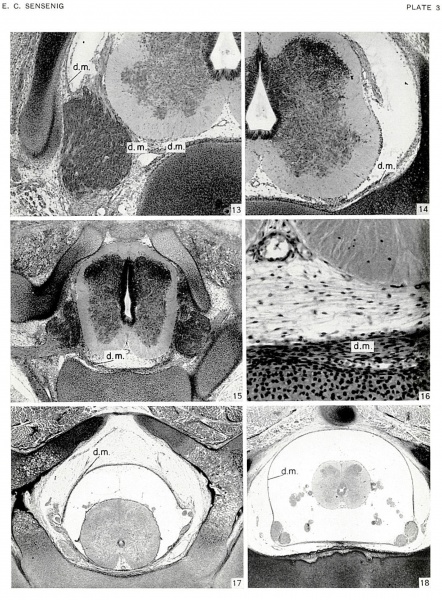File:Sensenig1951 plate03.jpg

Original file (1,963 × 2,664 pixels, file size: 1.33 MB, MIME type: image/jpeg)
Plate 3
Fig. 13. Transverse section through centrum of lower cervical region of Carnegie Embryo No. 4570, 30.7 mm, age group xxiii, cut 15 microns x75. The ganglia are entering the intervertebral foramina. Ventral dura passing laterally splits to surround large venous channel and then invests ganglia. Dura rudiment present dorsal to ganglion against lateral wall of vertebral canal. Subdural cavity forming.
Fig. 14. Transverse section through intervertebral disk of Carnegie Embryo No. 4570, 30.7 mm, age group xxiii, cut 15 microns x75. Dura rudiment may be identified to tip of neural arches and along ventral part of closure membrane. Note development of subdural space.
Fig. 15. Transverse section of mid-thoracic region of Carnegie Embryo No. 6573 31.3 mm, age group xxiii, cut 30 microns. x50. Dorsal canal wall compressed. Ventral dura distinct and separating from underlying perichondrium.
Fig. 16. Same section as figure 15. x300. Shows stratification of cells ventral to anterior median sulcus. Dura separating, except in mid-line, from underlying perichondrium of intervertebral disk.
Fig. 17. Transverse section of mid-thoracic region of Carnegie Embryo No. 7218, 80.0 mm cut 20 micron. x30. Dura mater now is a distinct membrane with subdural and epidural cavities formed. Note cell-free subdural cavity, and large venous channels in ventrolateral part of epidural space.
Fig. 18. Transverse section of lumbar region of Carnegie Embryo No. 7218, 80.0 mm cut 20 micron. x30. Shows complete dural sac of lumbar region, and subdural and epidural spaces.
Abbreviations used in Plates: d.1., dentate ligament d.m., dura mater d.p., dentate process m.p., meninx primitiva n.c., neural crest n.c.c., neural-crest cells n.p., neural process p., perichondrium pm., rudimentary posterior longitudinal ligament s., somite :p.c., spinal cord :p.g., spinal ganglion
| Historic Disclaimer - information about historic embryology pages |
|---|
| Pages where the terms "Historic" (textbooks, papers, people, recommendations) appear on this site, and sections within pages where this disclaimer appears, indicate that the content and scientific understanding are specific to the time of publication. This means that while some scientific descriptions are still accurate, the terminology and interpretation of the developmental mechanisms reflect the understanding at the time of original publication and those of the preceding periods, these terms, interpretations and recommendations may not reflect our current scientific understanding. (More? Embryology History | Historic Embryology Papers) |
- Links: plate 1 | plate 2 | plate 3 | plate 4 | Sensenig 1951 | Spinal Cord | Meninges
Reference
Sensenig EC. The early development of the meninges of the spinal cord in human embryos. (1951) Contrib. Embryol., Carnegie Inst. Wash. Publ. 611.
Cite this page: Hill, M.A. (2024, April 26) Embryology Sensenig1951 plate03.jpg. Retrieved from https://embryology.med.unsw.edu.au/embryology/index.php/File:Sensenig1951_plate03.jpg
- © Dr Mark Hill 2024, UNSW Embryology ISBN: 978 0 7334 2609 4 - UNSW CRICOS Provider Code No. 00098G
File history
Click on a date/time to view the file as it appeared at that time.
| Date/Time | Thumbnail | Dimensions | User | Comment | |
|---|---|---|---|---|---|
| current | 15:21, 5 June 2016 |  | 1,963 × 2,664 (1.33 MB) | Z8600021 (talk | contribs) |
You cannot overwrite this file.
File usage
The following 2 pages use this file:
